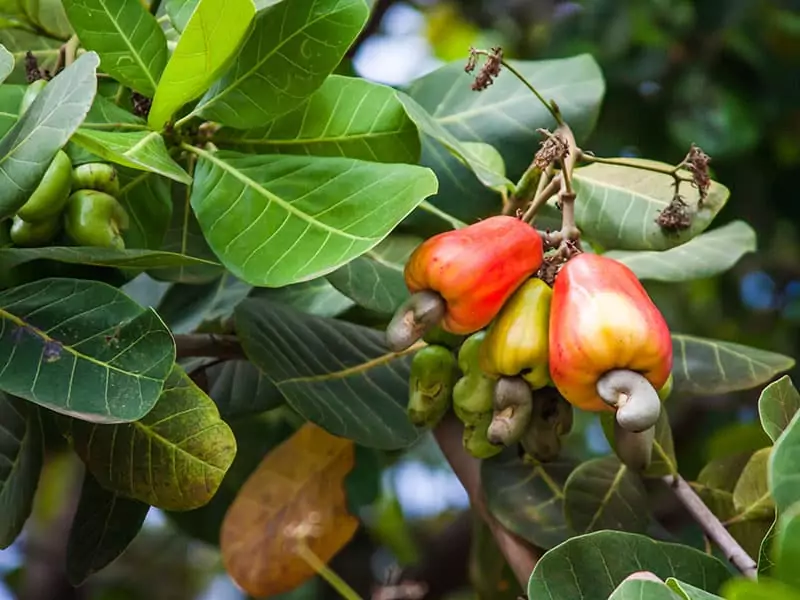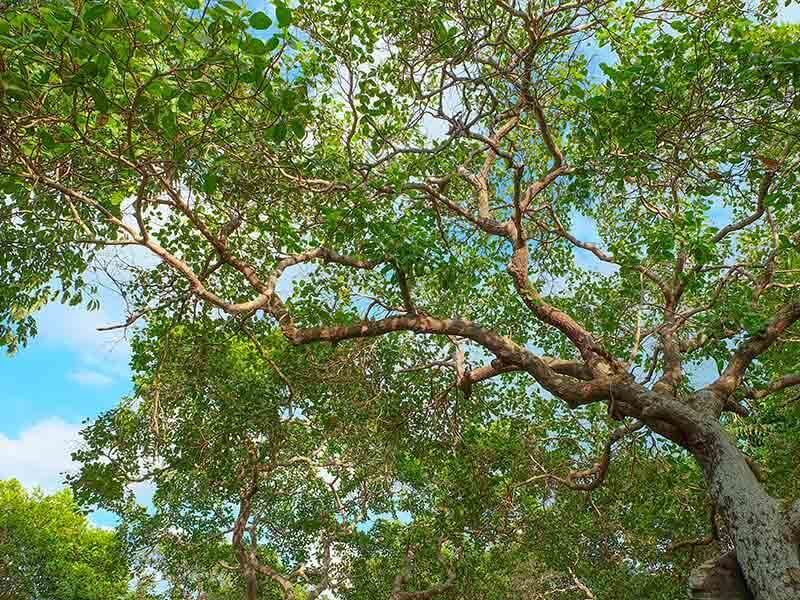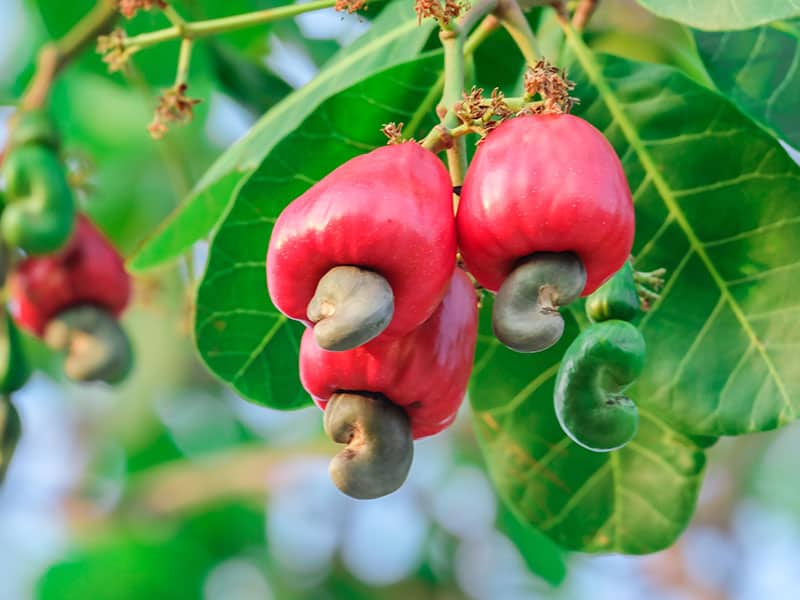How To Grow A Cashew Tree
Have you ever wanted your own cashew nuts, but you didn’t know how to grow a cashew tree? In this article, you’ll find everything you need to know about growing cashew trees from seeds, proper care, harvesting, the difference between standard and dwarf cashew varieties and plenty of other useful information.
At a glance, cashew nuts are simple to grow. But, you still have to provide the ideal growing environment for the tree. If you succeed, you can expect your tree to produce juicy cashew apples and healthy nuts after a while.
Another thing worth mentioning is that growing cashew trees is a profitable business. So, if you are thinking about it, you can use the information from the article as a starting point.
Before I walk you through the comprehensive guide on growing cashew trees at home, let’s unravel some things about cashew trees in general.

What Is A Cashew Tree?
Anacardium occidentale is the scientific name of a cashew tree, and it describes a tropical tree with evergreen foliage and edible fruits and seeds. Cashew seeds are called cashew nuts and are eaten as healthy snacks. You can also make cashew butter from nuts or cashew cheese, a special delicacy.
Cashew fruits are called apples and they come in yellow color with a reddish hue. People eat them fresh, use them in juices, liqueurs, and recipes.
The tree comes from Brazil and Venezuela, where you can find the tallest cashew trees. Some of them are more than 40 feet tall in their native habitat. If you provide the ideal conditions, the cashew tree will grow between 20 and 40 feet.
Evergreen foliage has a leather texture and a distinctly elliptical shape. Cashew tree flowers are five-petalled and have a reddish shade.
Interesting facts about cashew nuts.
Cashew Tree: Standard VS Dwarf Variety
The obvious difference between the cashew tree and its dwarf hybrid is height. Dwarf cashew doesn’t grow over 20 feet and produces fruit one year after planting.
The standard cashew tree is twice as tall and needs three years to bear fruits. For example, the recently developed variety of cashew is called Netra Vaman and is supposed to help people grow cashew on their terraces. The nuts are significantly smaller than standard nuts, and the fruits are small and lightweight.
The average fruit from the Netra Vaman tree weighs less than two ounces. Also, some dwarf cultivars are produced with better pest and disease resistance than native plants.
Growing Cashew Tree: Comprehensive Guide From Scratch
Cashew is native to tropical climates and frost-sensitive so only lucky people in Florida, Puerto Rico, and Hawaii can grow the tree in their homes in the US.
Also, because of the limited locations for growth, the US doesn’t have a large industrial production of cashew nuts. But, you can start a small business, if you get familiar with cashew growing requirements.
In the mentioned locations, you can see cashews in botanical gardens and home landscapes. Before you start, read the following cashew growing guide.

Choosing Location
The first step to ensure the successful growth of the cashew tree is to pick the site well. Cashew trees need full sun exposure to bear fruits. Keep the tree away from other trees, large structures, and anything that can provide shade.
Keep in mind that the cashew tree will grow tall soon, so ensure you’ve got enough space for the tree to develop.
Further, cashew trees need warmth, so select a place in your garden which doesn’t flood during heavy summer rains. The area shouldn’t be prone to flooding. If your garden is flat, you can build a mound using the soul, and slightly elevate your tree. It will help with the soil drainage and keep the tree safe from floods.
Planting
Now when you’ve got the ideal planting site for your cashew tree, choose the timing wisely. Planting during the hottest part of the year from June to August is the best.
It is also the time of the year with the most rain, so hot and wet conditions will help the plant establish soon. Also, good planting timing prepares the plant for cooler fall weather and improves its drought tolerance.
Ideal Soil Type For Cashew Tree
Cashew trees grow in well-draining soil, and are adapted to most soil types. But, the tree grows best in soil with sand content as those enhance fruit production.
How To Plant?
If you plant the tree properly, you have better chances for the plant to establish and start growing as a healthy and fruit-bearing tree.
Growing cashew from seed is more challenging. Start the seed in pots and keep the soil moist. Within five days, you should see sproutings.
Or, pick a healthy plant from the nursery, which is carried in an average size pot. Before you plant the tree, water it regularly and check the tree for any signs of pests and diseases. Then, remove the bottom part of the container before you plant it in the soil. That way, you’ll minimize the shock for the roots and your plant will remain healthy.
Dig the hole in the ground, loosen the soil around and put the bottomless container in it. The plant needs to be three times the diameter and depth of the container.
Carefully remove the sides of the container and remove the container from the plant. Backfill your plant and water the plant thoroughly!
More tips for growing cashew trees from seeds.
Caring For The Tree
Once your plant tree has been established, you need to take good care of it to keep the plant healthy. Here is what you need to know about fertilization, watering, pruning, mulching, pests control and more.
Fertilization
Fertilization is an important step when taking care of your cashew tree. In South Florida, use a fertilizer every month during the first year after planting. You can start with 1/4 of a pound and slowly increase until you reach a maximum of one pound of fertilization.
Pick a fertilizer that contains equal amounts of nitrogen, phosphorus, potassium. Magnesium content needs to be slightly lower. Older trees will do well with any kind of fertilizer. On the other hand, if the soil in your garden is calcareous, feed the cashew tree copper, zinc, manganese, and a tiny amount of boron.
Watering
When you first plant it, your cashew tree needs a lot of water. In the first two weeks, water the tree every other day. Then, slowly reduce to two times per week until you get into the schedule of one watering per week.
Of course, during the rainy season, the watering frequency.
As the plant matures, the watering needs drops. So, trees older than four years only need occasional watering during extreme droughts!
Also, during fall and winter, most trees don’t need additional watering. Too much water can make the plant ill.
Pruning
Pruning is a necessary part of the regular maintenance of cashew trees. The first two years after planting, you need to remove shoot tips occasionally, preferably in spring and summer. It will help with the branching and encourage fresh growth. Also, removing two inches of shots keeps the tree compact and well-structured.
After several years, cut ten feet of the treetop. And then, only remove several branches on the treetop each year. It will keep the tree compact and make harvesting the tree much simpler.
The ideal time for pruning is after harvest.
Also, if your tree grows taller than 30 feet, call a professional to prune it. Pruning such tall trees is extremely dangerous and should be taken with extreme caution.
Precautions
Cashew trees do improve the landscape significantly. But, when mowing the lawn, try not to hit the tree trunk with a mower and never use the weed killer near the tree. Remove weeds manually instead of using mechanical and chemical weed killers.
Mulching
To improve the soil moisture and reduce weed problems around the cashew tree trunk, mulch around the tree.
Use a three-inch layer of wood chips and bark to mulch around the tree trunk, but keep the mixture ten inches from the trunk.
Common Insects Problems
Generally, cashew trees aren’t prone to insects in South Florida and they will rarely cause any severe problems. But, beetles and moths, caterpillars, and other insects that attack flowers may attack cashew trees. Sometimes, they can even attack the fruits, so keep an eye on the plant for signs of pests.
If you notice any problem, consult the agricultural agent of your country, rather than dealing with the problem yourself.
Cashew Tree Diseases
If you have followed the most important guidelines for planting cashew trees, your tree will be less prone to diseases.
Most commonly, cashew trees may suffer from anthracnose and powdery mildew – fungal diseases.
You can deal with these issues if you spot the problem on time. Generally, inspect the new growth, flowers, and young fruits for signs of fungal problems. Use a copper-based fungicide reinforced with sulfur.
Coat all affected parts of the plant thoroughly and reapply the fungicide if it rains in several days.
Harvesting Fruits
You should harvest fruits from the tree when they are ripe. The fruits need to turn from green to red or yellow when mature. You can pick the fruit from branches or wait for it to fall on the ground.
The fruit ripens at room temperatures and needs to be fully ripe before you put it in the fridge.

Harvesting Nuts
Cashew nuts are ready for harvesting two months after the fruit appears. The apples should become red and the nuts should be visible and grey.
Harvesting is simple – you can simply pick the nut from the apple. You can also harvest nuts from the fallen apples, by twisting them with your hands.
Cashew nuts appear on the bottom of the fruit. Each apple, called a pseudo-fruit because it is part of the swollen stem, contains one nut. Nuts and fruits only appear during winter or dry seasons.
After harvesting, store cashew nuts in a cool and dry place. If you store them well, they can remain fresh for two years!
Growing Cashew Trees As A Small Business
If you want to start cashew farming, you’ll need to create a plant protection plan, a business plan, invest in your plants, and secure good pests and disease control. Growing cashew for a business is solely done for the nuts.
Nuts are used for sweets, pastries, ice cream, cakes, and chocolate. Additionally, nut oil is used for cosmetic and pharmaceutical purposes.
Therefore, there are so many opportunities with cashew trees. You can also make the products from cashew nuts, such as butter, and sell them.
Quick recipe for cashew butter.
Frequently Asked Questions
Let’s answer some commonly asked questions about growing cashew trees! If you don’t see your question, please ask me in the comments!
Cashew Tree: Grow Healthy Nuts and Fruits in Your Backyard
People who grow in warm parts of the USA, such as Florida and Hawaii can grow their cashew trees in their backyard! One tree may be enough for the needs of the average family, and you can save money and improve your landscape at the same time.
Also, if you prune the tree well, it will keep the canopy tidy and provide shade for the hot summer afternoons! From all perspectives, growing a cashew tree is a win-win!
Would you consider growing a cashew tree? Why?
If you enjoyed the article, don’t forget to hit the like button!

